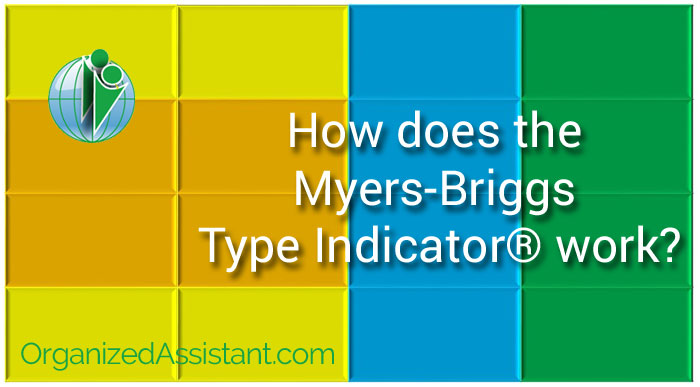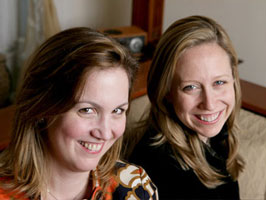How does the Myers-Briggs Type Indicator® work?

This page may contain links to Amazon.com or other sites from which I may receive commission on purchases you make after clicking on such links. Read my full Disclosure Policy
The Myers-Briggs Type Indicator®, or MBTI®, is a self-report questionnaire designed to help people determine their personality type. Here’s how it works.
Your responses to the assessment questions indicate your preferences in the following four areas:
- Direction of focus and source of energy
- Taking in information
- Making decisions
- Dealing with the outer world
Let’s look at each of those areas closely.
Direction of Focus and Source of Energy
People who prefer Extraversion direct their energy and attention outward. They receive energy from interacting with people and from taking action. People who prefer Introversion like to focus on their own inner world of ideas and experiences. They receive energy from reflecting on their thoughts.
If you prefer Extraversion, you are likely to:
- Act or speak before thinking
- Think best when talking to other people
- Take the initiative in making contact with other people
- Have broad friendships with many people
- Prefer spoken communication
- Tolerate noise and crowds
- Get restless without involvement with other people or activities
- Be equally at ease in a group or one-on-one
- Share personal information easily
- Become impatient and bored when your work is slow and unchanging
If you prefer Introversion, you are likely to:
- Think before acting or speaking
- Think best when alone
- Usually let other people initiate contact
- Have a few deep friendships
- Prefer written communication
- Avoid crowds and seek quiet
- Get agitated without enough alone time
- Prefer communicating one-on-one
- Share personal information only after trust has been established
- Become impatient and annoyed when your work is interrupted and rushed
Ways of Taking in Information
People who prefer Sensing like to take in information that is real and tangible – what is actually happening. They are observant about the specifics of what is going on around them and are especially tuned into practical realities. People who prefer Intuition like to take in information by seeing the big picture, focusing on the relationships and connections between facts. They want to grasp patterns and are especially tuned into seeing new possibilities.
If you prefer Sensing, you are likely to:
- Gather information through your senses: sight, sound, feel, taste and smell
- Look at specific details
- Deal with known facts
- Live in the present or past, enjoying what is or what was
- Learn step-by-step through observation and imitation
- Trust experience more than inspiration
- Prefer precise and exact information
- Appreciate and enjoy traditional and familiar ground
- Communicate by presenting the facts and details first
- See predictability as vital to your relationships
- Prefer to use existing skills rather than to take the time to learn new ones
If you prefer Intuition, you are likely to:
- Gather information by way of a “sixth sense†or a hunch
- Look at patterns and relationships
- Deal with possibilities
- Live in the future, anticipating what might be
- Learn by seeing connections and through general concepts
- Trust inspiration more than experience
- Prefer approximations and generalizations
- Appreciate and enjoy new and different experiences
- Communicate by presenting insights and ideas first
- See change as vital to your relationships
- Enjoy learning new skills for the challenge and novelty involved
Ways of Making Decisions
People who prefer Thinking like to look at the pros and cons of a situation and base their decisions on logical reasons and consequences. Their goal is to find a standard or principle that will apply in all similar situations. People who prefer Feeling like to base their decisions on personal values. Their goal is to create harmony and to treat each person as unique.
If you prefer Thinking, you are likely to:
- Decide with your head
- Base your decisions on logic
- Consider all the pros and cons
- Value fairness and reasonableness
- Analyze information
- Tend to question other people’s findings
- Notice ineffective reasoning
- Choose truthfulness over tactfulness
- Prefer brief and concise communication
- Show caring more impersonally
- Be task-oriented in the workplace
If you prefer Feeling, you are likely to:
- Decide with your heart
- Base your decisions on personal values – what you like or don’t like
- Consider the impact of your decisions on other people
- Value harmony and compassion
- Understand people
- Tend to agree with other people’s findings
- Notice when people need support
- Choose tactfulness over truthfulness
- Prefer social, friendly and even time-consuming communication
- Show caring through personalized words and actions
- Be relationship-oriented in the workplace
Ways of Dealing with the Outer World
People who prefer Judging like to live in a planned, orderly way, seeking to regulate and manage their lives. Sticking to a plan and schedule is important to them, and they are energized by getting things done. People who prefer Perceiving like to live in a flexible, spontaneous way, seeking to experience life rather than control it. Detailed plans and final decisions feel confining to them – they prefer to stay open to new information and last-minute options.
If you prefer Judging, you are likely to:
- Have a decisive, planned and orderly lifestyle
- Like a definite order and structure
- Prefer to reach conclusions
- Enjoy finishing things
- Desire to do the right thing
- Dislike surprises and last minute changes
- Work before play
- Respect and feel comfortable with traditional relationships
- Work best with a plan
- Like checking things off a “to do†list
If you prefer Perceiving, you are likely to:
- Have a flexible, adaptable and spontaneous lifestyle
- Like going with the flow
- Prefer to keep things open
- Enjoy starting things
- Desire to have many experiences
- Like surprises and last minute changes
- Seek opportunities to combine work and play
- Feel hemmed in and restricted by traditional relationships
- Work best when you can deal with issues as they come up
- Ignore your “to do†list, if you even make one
Your preferences in these four areas combine to form YOUR personality type! As there are 16 possible combinations, there are 16 personality types, each with its unique organizing profile.
Did you find this post helpful?
Share it with your network, and sign up to get new posts by email every week!











This is always a fun group exercise, and I do believe the test results tend to be very accurate in helping us understand the way we process and interact with the world. I can’t quite remember what my result is, but now you’ve got me interested. I think I will go back and check!
I hope you can find it. It will be interesting when I post the organizing profiles, to see how well it reflects you.
I was just saying the other day that I hadn’t take this in years, since a team retreat in my corporate days in fact. I’ve become quite a mixture of both measures in each category! Nicely explained, Janet !
You must be all grown up now, Sue. 🙂 You probably still have your preferred modes of doing things, but you’re now able to adapt more easily than in your younger years.
Great post, Janet. I can see my personality in all of these types depending on the situation. However, in dealing with the outside world, I can see clearly that I am more of a “judging” type as opposed to “perceiving” type. Thanks for sharing. This was fun.
When I got involved with professional organizing, I assumed that all POs would be judging types. I quickly learned that I was wrong – that many have learned the hard way and now share what they learned with their clients.
Thanks for the concise explanations, Janet! It does help to understand ourselves and others. The different types aren’t better than others–just different. And that can be a very good thing!!
I love the way you express it – not better, just different! When I read I’m Not Crazy, I’m Just Not You in preparation for the MBTI training program, it was a real eye-opener. I highly recommend it!